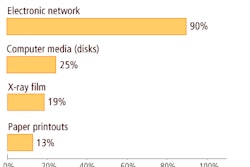Risk prevention and patient safety programs are the best strategies for avoiding malpractice liability as institutions convert to digital environments, according to Spencer Studwell, a senior associate general counsel and director of risk management at the University of Rochester Medical Center in Rochester, NY.
While moving to digital offers a number of benefits, it also introduces new risks for medical liability. The most obvious is the potential for lost images, according to Studwell, who spoke during a talk at the PACS 2007 conference in San Antonio, sponsored by the University of Rochester School of Medicine & Dentistry in Rochester, NY.
"It is still, at least to my mind, something of a leap of faith to believe that after we've reduced these images to ... pixels, that we're going to be able to retrieve them from our system," he said.
A number of recent cases suggest that some significant risks are associated with this potential for lost images, according to Studwell. For example, an Oregon hospital lost 5,000 images in 2006 following a hard drive crash.
In addition to the obvious impact on care, lost images could have an impact on litigation, including the potential for a spoliation claim. This involves a request for an adverse inference charge from the judge presiding over the malpractice trial. Plaintiffs could argue that it's no accident that these records are missing, and ask the judge to instruct the jury that they are free to infer that if the records or images are available, that they would support the plaintiff's version of the case, Studwell said.
"It's an extraordinarily damaging charge if the court agrees to give it, and the court could agree to give it if we don't have a good reason to explain why we don't have those images available," he said.
For the sake of patient care and risk management, it's critical to have reliable systems in place for archiving and retrieval, as well as disaster recovery, Studwell said. It's a good idea to be aware of what peers are doing, as the standard of care is defined by peer behavior, he added.
Compression also creates another set of risks. "The question we should be asking is whether compressed images are adequate for diagnostic purposes, and whether they're currently adequate and whether they're going to be adequate if that same patient comes back in the future," Studwell said.
From a risk-management perspective, it's going to be extraordinarily difficult to defend a "failure to diagnose" case involving lossy-compressed images, he said.
"Plaintiffs' attorneys are getting increasingly sophisticated with regards to these issues, and they will press this point," Studwell said.
Failure to diagnose
The most common allegation against radiologists today in malpractice litigation involves "failure to diagnose" claims.
"We certainly know that not every miss is medical malpractice, but to overcome the hindsight bias that's going to exist in these cases -- both with regards to the outcome and the irrefutable fact that the wrong diagnosis was made -- we must be able to establish the quality of the image, the adequacy of the equipment, and the environment that was involved in interpreting the image, including the adequacy of the workstation and the difficulty of the diagnosis and the competency of the reviewer," Studwell said.
In addition to technical factors, the digital environment adds clinical practice risks, raising the bar of expectations regarding "virtual availability," he said. Risks include patient and provider satisfaction, delays that may increase potential for liability, and simultaneous multiple provider access risk, Studwell said.
"The movement to digital is not in any way a magic bullet. There are still many, many opportunities for medical malpractice risk," he said.
Human mistakes can also have an effect. Images can be mislabeled, the wrong images can be read, and images can be misinterpreted, Studwell said.
Persistent themes from recent malpractice claims in which the court decided in favor of the plaintiff include a failure to consult a prior study or report, limitations in imaging technique, an incomplete medical history, lesion outside of area of interest/focus, failure to continue search after one specific finding, and a failure to recommend other studies, he said.
In addition, discrepancies between preliminary and final interpretations may also still occur. Systems need to track and document image access, and preliminary impressions should be captured and preserved; significant changes to preliminary findings need to be documented and communicated, Studwell said.
Failure to communicate
Risks of communication failure continue in the digital environment, Studwell said. He recommends following the American College of Radiology (ACR) Standard for Communication; if immediate treatment is indicated, radiologists should communicate directly with the referring physician.
Communication breakdowns make up 70% to 80% of malpractice claims against radiologists, he said. Common themes from lost claims include radiologic findings delayed or not received by the referring physician, failure to mention an inconclusive or incidental finding, or a failure to notify a self-referred patient of an abnormal result.
The plaintiff's burden to prove causation in a medical malpractice case is alarmingly easy to satisfy, Studwell said.
It's important to recognize that there's a risk of higher indemnity awards in failure to communicate claims, as a failure to diagnose might be viewed as a honest mistake. A failure to communicate involves knowing the patient was at risk but failing to take steps to protect them. Jurors are first and foremost patients themselves, he said.
"It's hard for jurors to judge the level of care, but easy for them to judge the level of caring," Studwell said.
In one case involving a 46-year-old male presenting to the primary care physician (PCP) for a routine physical, the PCP noted a epigastric pulsatile mass in the abdomen, and referred the patient for an abdominal sonogram to rule out aortic aneurysm.
The radiologist noted that the aorta was normal but there was questionable echogenic area in the right kidney; if clinically indicated, CT could be considered.
The PCP didn't order any follow-up exams, and one year later, the patent was diagnosed with renal cell cancer of the right kidney. A lawsuit was filed against the PCP and the radiologist.
The PCP testified that he never received the written report and never called about the kidney finding. The plaintiff's expert radiologists testified that the standard of care clearly requires radiologist to directly call the PCP with the unexpected diagnostic finding, citing the ACR standard. The case ultimately had to be settled, Studwell said.
"The lesson here of this particular case is that it's important that we develop reliable systems for closing the loop, and that we document that the loop has been closed," he said.
In another case involving a failure to report a change from the preliminary interpretation, a 51-year-old female presented to the emergency department (ED) with complaints of chest pain, moderate dyspnea, and low-grade fever.
A chest x-ray was ordered, and interpreted by the ED physician as "mediastinal lymphadenopathy but no evidence of pneumonia." The patient was discharged with instructions to contact the PCP for a "shadow on x-ray."
The next day, the attending radiologist found a "right suprahilar mass with mediastinal widening, suggestive of bronchogenic carcinoma," Studwell said. The report was sent to the ED and PCP but no call was made. The patient did not contact the PCP, and a significant delay in diagnosis led to death secondary to lung cancer, he said.
A suit was filed against the ED physician, PCP, and the radiologist. An expert testified that the ACR standard calls for a discrepancy to be directly communicated to the referring physician.
The defense said that the difference between mediastinal lymphadenopathy and suprahilar mass with mediastinal widening was minor and did not rise to the level of warranting a direct call. However, the PCP did not agree and testified that he would have managed the case differently if he had the other information. The case was settled, Studwell said.
"One of the lessons we can take away from this particular case is to have a low threshold for reporting discrepancy between a preliminary and a final read," he said.
Despite the transition to digital environments, the communication risk has not diminished, Studwell said. It's important to keep in mind that communication failures are now the second most common malpractice claim against radiologists.
"Understand that the ACR standard will be described as the standard of care (in malpractice litigation)," he said.
Systems and a policy of communication should be established, including when and to whom to report the results, he said. In addition, most systems will track time and date access, as well as changes to imaging reports.
"Any changes to a report relative to malpractice litigation will be discovered," Studwell said. Facility privacy and security rules should also be understood, he added.
By Erik L. Ridley
AuntMinnie.com staff writer
May 15, 2007
Related Reading
Malpractice juries usually side with physicians, April 12, 2007
Row in Italy over medical malpractice death figures, October 25, 2006
Bush prods Congress on medical liability limits, August 23, 2006
Expert physician witnesses in birth injury litigation may be substandard, July 31, 2006
Ob/gyn ultrasound yields thorny legal issues, July 13, 2006
Copyright © 2007 AuntMinnie.com




















